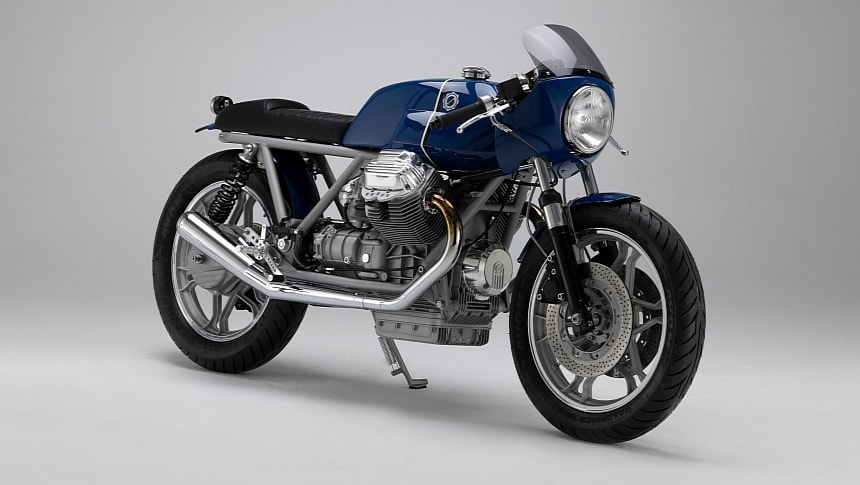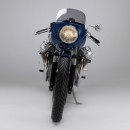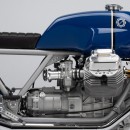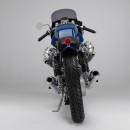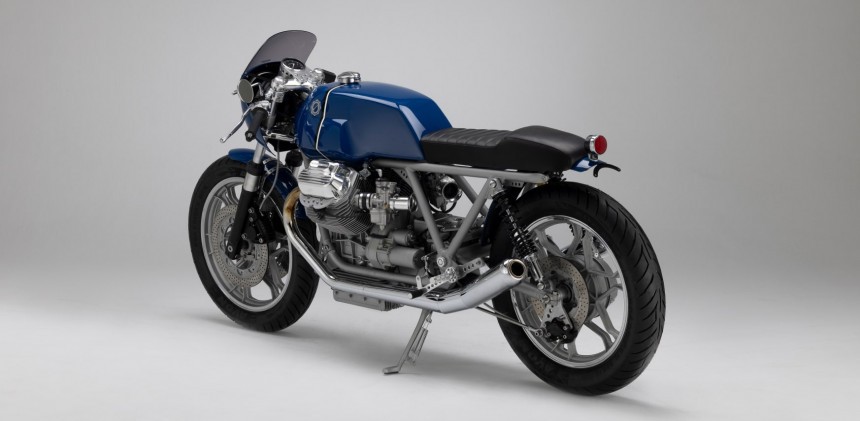Classic Moto Guzzi bikes have a distinct charm that makes them great donors for customization, and there is one builder who knows this better than most. We are, of course, talking about Axel Budde of Kaffeemaschine, a man whose work has been featured extensively by the motorcycling press over the years. If you’ve got at least a passing interest in custom bike culture, chances are you’ve already seen what he can pull off.
The motorcycle shown above can easily be recognized as a Kaffeemaschine build from a mile away, hosting all the cool traits of Axel’s signature style. At the same time, it clearly distinguishes itself from all his previous projects with a unique colorway and many other tasty features. Our protagonist selected a Moto Guzzi Le Mans III from 1984 as the starting point for this conversion.
Upon arrival at his facility in Hamburg, the donor was promptly dismantled and many of its original bits got taken out of the equation. The build was commissioned by a Norwegian client named Florian, who was more than happy to give Axel carte blanche and let him do his thing. With the Mark III (or what was left of it) on his workbench, Herr Budde dug straight in.
For starters, he had the iconic Tonti frame cleaned up and finished in a layer of matte-grey, so as to make it look brand-new. As all the original bodywork had been ditched during the initial teardown, the German mastermind needed to source some appropriate replacements or fabricate them from scratch. In the center, he installed the modified fuel tank of a Le Mans II, which had previously been lengthened to achieve the desired proportions.
The front end is home to a tailor-made carbon fiber fairing, neatly encircling a retro-looking headlamp and topped with a tinted windshield. We find an aluminum front fender placed lower down, and there is also a discreet mudguard located at the back. Its rearmost tip supports a circular LED taillight and a bare-bones license plate bracket, all fronted by a gorgeous handmade saddle.
This new seat comes with black leather upholstery and a raised rear section giving the impression of a cafe racer tail unit. Although the vast majority of Kaffeemaschine’s builds are given laced hoops, this particular machine retains the factory wheels from Moto Guzzi. They’ve been revamped, finished in matte-grey just like the frame, and ultimately shod in a grippy pair of Avon tires.
Just about every motorcycle to receive Axel’s custom treatment is sure to also get some serious performance upgrades, and this one is no different. Starting with the suspension department, he replaced the OEM shock absorbers with modern aftermarket alternatives from Ikon. The standard forks are still present at the front, but their internals have been thoroughly upgraded for smoother handling.
Stopping power comes from drilled discs and Brembo calipers on both ends, all operated via braided brake lines. The Le Mans III could also use some additional ponies, so its longitudinal V-twin was completely revamped inside out. Now displacing a very healthy 1,000cc, the rebuilt engine can deliver up to 84 hp for Florian to play with. It also benefits from a fresh electronic ignition and custom breathing equipment.
Air flows in through tailor-made velocity stacks, and combustion by-products are channeled out into the atmosphere via a bespoke stainless-steel exhaust system. The twin piping was built in Axel’s signature style, it being one of the features that doesn’t change very much from one build to the next. All the electronics were rewired through a Motogadget controller, without a single unsightly wire left exposed once the job was done.
Up in the cockpit area, we’re greeted by a multi-function Motogadget ChronoClassic dial encased in a bespoke billet aluminum housing. New clip-on handlebars also make an appearance, complete with bar-end turn signals, black rubber grips, and a single rear-view mirror on the left. To bring the cafe racer ergonomics full circle, the project’s author also added CNC-machined rearsets to the mix.
Now then, we finally arrive at the deep blue finish covering the tank, fenders, and front fairing. The hue was sourced from Alfa Romeo’s color palette and topped with vertical black and white pinstriping on the gas tank. Kaffeemaschine badges are present in that area, as well, but matte-grey and chrome are the name of the game everywhere else you look. All this makes for a simple, yet undeniably alluring cosmetic package.
A considerable weight reduction has resulted from Axel Budde’s makeover, too, with the creature now tipping the scales at 184 kilograms (406 pounds). Long story short, there’s not a single component on this motorcycle that hasn’t been refurbished, upgraded, or replaced altogether. That’s precisely what we’ve come to expect from a workshop like Kaffeemaschine, as it seems to be just business as usual for its talented frontman.
Upon arrival at his facility in Hamburg, the donor was promptly dismantled and many of its original bits got taken out of the equation. The build was commissioned by a Norwegian client named Florian, who was more than happy to give Axel carte blanche and let him do his thing. With the Mark III (or what was left of it) on his workbench, Herr Budde dug straight in.
For starters, he had the iconic Tonti frame cleaned up and finished in a layer of matte-grey, so as to make it look brand-new. As all the original bodywork had been ditched during the initial teardown, the German mastermind needed to source some appropriate replacements or fabricate them from scratch. In the center, he installed the modified fuel tank of a Le Mans II, which had previously been lengthened to achieve the desired proportions.
The front end is home to a tailor-made carbon fiber fairing, neatly encircling a retro-looking headlamp and topped with a tinted windshield. We find an aluminum front fender placed lower down, and there is also a discreet mudguard located at the back. Its rearmost tip supports a circular LED taillight and a bare-bones license plate bracket, all fronted by a gorgeous handmade saddle.
Just about every motorcycle to receive Axel’s custom treatment is sure to also get some serious performance upgrades, and this one is no different. Starting with the suspension department, he replaced the OEM shock absorbers with modern aftermarket alternatives from Ikon. The standard forks are still present at the front, but their internals have been thoroughly upgraded for smoother handling.
Stopping power comes from drilled discs and Brembo calipers on both ends, all operated via braided brake lines. The Le Mans III could also use some additional ponies, so its longitudinal V-twin was completely revamped inside out. Now displacing a very healthy 1,000cc, the rebuilt engine can deliver up to 84 hp for Florian to play with. It also benefits from a fresh electronic ignition and custom breathing equipment.
Up in the cockpit area, we’re greeted by a multi-function Motogadget ChronoClassic dial encased in a bespoke billet aluminum housing. New clip-on handlebars also make an appearance, complete with bar-end turn signals, black rubber grips, and a single rear-view mirror on the left. To bring the cafe racer ergonomics full circle, the project’s author also added CNC-machined rearsets to the mix.
Now then, we finally arrive at the deep blue finish covering the tank, fenders, and front fairing. The hue was sourced from Alfa Romeo’s color palette and topped with vertical black and white pinstriping on the gas tank. Kaffeemaschine badges are present in that area, as well, but matte-grey and chrome are the name of the game everywhere else you look. All this makes for a simple, yet undeniably alluring cosmetic package.
A considerable weight reduction has resulted from Axel Budde’s makeover, too, with the creature now tipping the scales at 184 kilograms (406 pounds). Long story short, there’s not a single component on this motorcycle that hasn’t been refurbished, upgraded, or replaced altogether. That’s precisely what we’ve come to expect from a workshop like Kaffeemaschine, as it seems to be just business as usual for its talented frontman.
